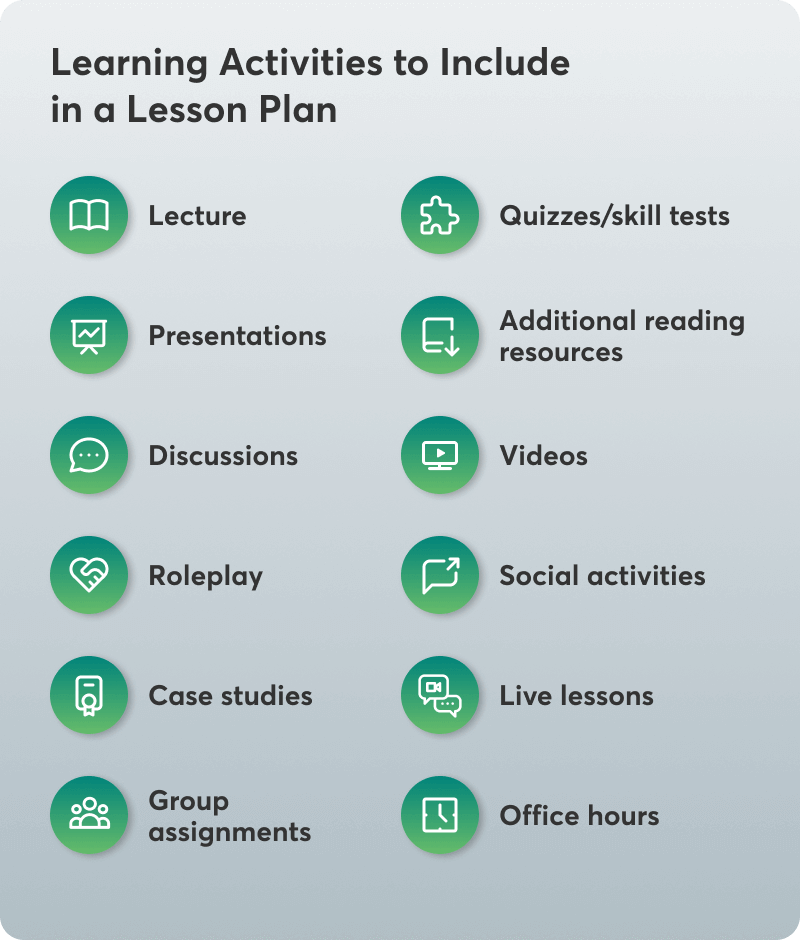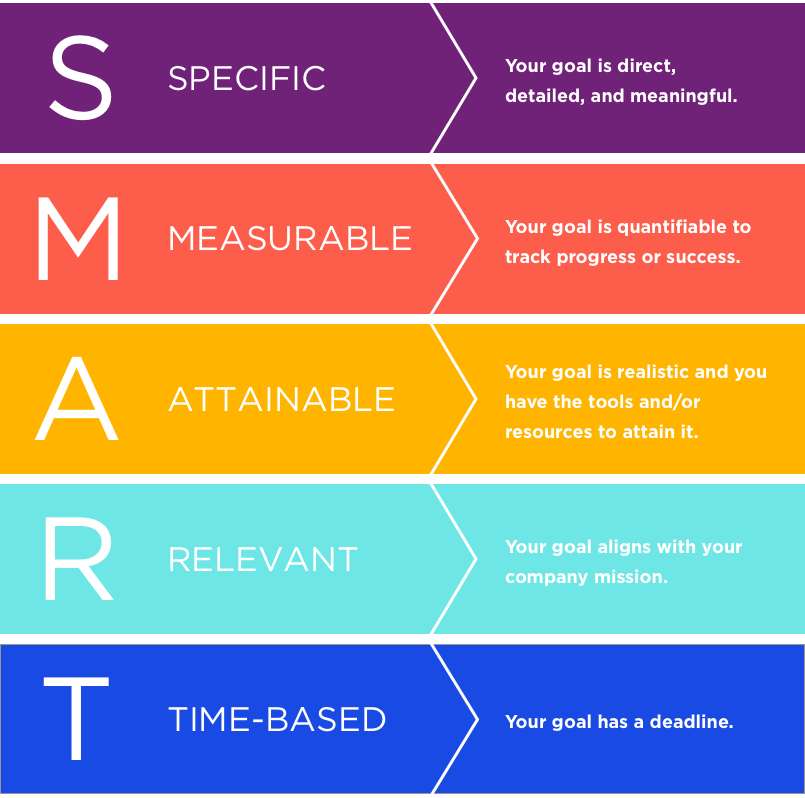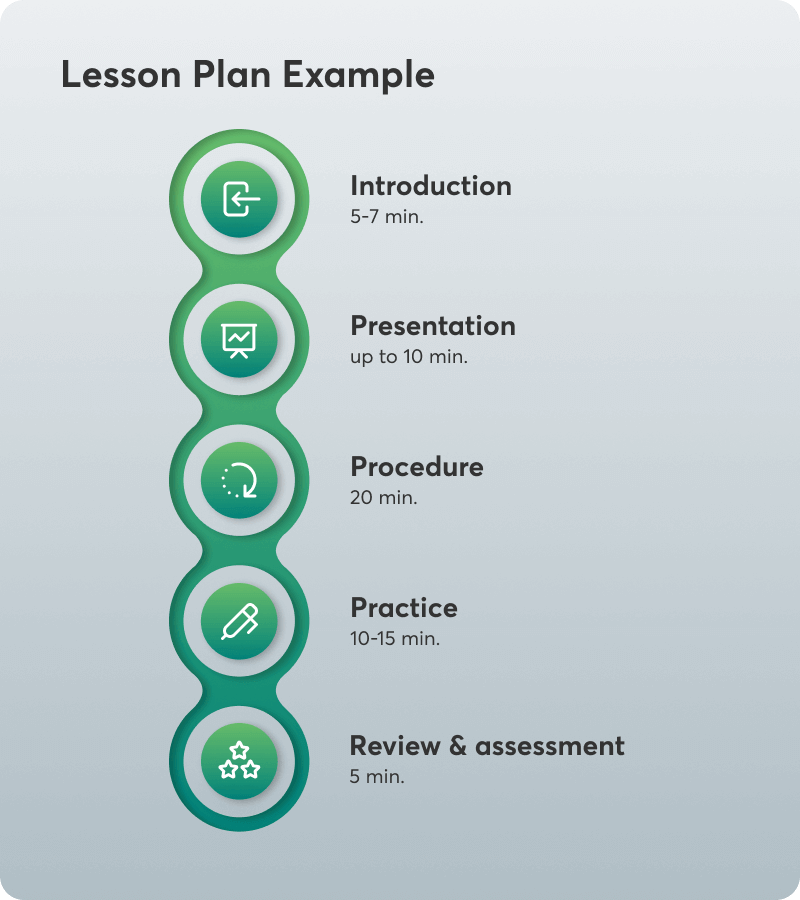Table of Contents
A well-crafted lesson plan is the backbone of effective teaching. It’s not just a list of activities but a roadmap guiding you through a learning journey.
It is an incredibly useful tool for both elearning and offline lessons. With a lesson plan, you can create a more effective training session, increase student understanding, and provide better learning experiences guided by the lesson objectives.
All educators must know how to create a lesson plan to ensure their learning sessions run smoothly. Depending on the students they teach and the timeline they have on their hands, educators set learning objectives, break the material up into sections, and choose learning activities that will be suitable for each trainee.
What is a Lesson Plan?
A lesson plan is a detailed step-by-step guide for educators providing materials to learners to accomplish their learning goals during the course.
It outlines the teacher’s objectives for the student’s accomplishments, the material to cover, and the delivery methods, including assignments, exams, and other evaluation forms.
A lesson plan is not a to-do list; it’s a strategic document that considers your students’ needs, your teaching style, and the subject matter at hand.
The key components of a lesson plan typically include:

The Learning Objectives
The foundation of any effective lesson plan is a set of clear, specific learning objectives. These objectives answer the question: “What should students know or be able to do by the end of this lesson?”
Make sure the learning objectives are SMART:

It’s crucial to align these objectives with the overall learning outcomes for the course or unit. When setting these objectives, consider your students’ prior knowledge and needs.
Are you building on previously learned skills or introducing entirely new concepts?
Understanding where your students come from helps you set realistic and meaningful objectives. Lesson plans for training may have different learning objectives, such as compliance or work-related skills, over teaching lesson plans that may have a goal of memorizing knowledge.
Planning the Lesson Structure
Planning a lesson structure is like creating a road map for your class time. A typical lesson structure includes an introduction, main activities, and a conclusion.
The top three items to include in your lesson plan for each activity are learning objectives, timing, and materials you’ll use. Your lesson plans may vary depending on the time limit and how many students are in a class.
A simple example of a lesson plan is the following:

Designing the Learning Activities
Learning activities are an essential part of your lesson. Make sure to include various kinds of activities to accommodate the different learning styles in the classroom, like:
Lecture: A lecture involves a teacher speaking to students about a specific topic, providing information, explanations, and sometimes visual aids to help students understand the material.
Presentations: Presentations allow students or teachers to share information on a topic using slides, images, and sometimes videos to make the content engaging and easier to understand.
Discussions: Discussions encourage students to talk about a topic in a group, sharing their ideas, opinions, and questions, which helps deepen their understanding and develop critical thinking skills.
Roleplay: Roleplay involves students acting out scenarios or characters to explore different perspectives and practice skills in a realistic context, making learning more interactive and engaging.
Case studies: Case studies examine real-life situations or problems, allowing learners to analyze, discuss, and learn from actual examples, helping them apply theoretical knowledge to practical situations.
Group assignments: Group assignments require students to work together on a task or project, promoting teamwork, communication, and collaboration while tackling a shared goal.
Quizzes/skill tests: Quizzes and skill tests are short assessments that help measure students’ understanding and retention of the material.
Additional reading resources: Additional reading resources are extra materials like books, articles, or online content that provide more information on a topic.
When teaching online, you can include activities suitable for online learning like:
Videos: Pre-recorded lectures or presentations students can watch at their own pace. For example, you can record your powerpoint presentation.
Social activities: Instead of group assignments, students can interact through the community of the LMS.
Live lessons: Live classes and workshops through Zoom, WebEx, or similar software can substitute for some live lessons and create a stronger connection than self-paced videos.
Office hours: Setting aside time for questions, whether that’s a live chat, phone call, or video call, the lecturer is available to students taking an asynchronous class.
While designing your lesson plan, consider whether you are teaching in a classroom or online or planning a mix of the two. While activities will vary in different settings, you need to keep your learners’ attention equally well in both settings.
Assessment and Evaluation Activities
Assessments help you understand whether your students have achieved the learning objectives and inform your future teaching. They can be smaller knowledge checks like quizzes or more demanding like an assignment or an exam.
Assessments are a very important learning tool as they assist with knowledge retention and test progress.
One type of evaluation is formative assessments, those are ongoing checks for understanding and include:
Summative assessments, on the other hand, evaluate student learning at the end of an instructional unit. These could be:
Many educators like to use rubrics to evaluate students’ work. Rubrics help evaluate students while being consistent in grading.

Reviewing and Refining the Lesson Plan
A lesson plan is never finished, and even online courses need reviewing an updating every few months.
You will find yourself coming back and updating various parts. Especially if you are writing a lesson plan for corporate training, where new skills and requirements are constantly being revised, you might end up reviewing your lesson plans often.
You will need to
Gaining feedback is also important. You can have feedback forms at the end of your lesson for students, or you can ask colleagues to offer feedback before publishing it.
Conclusion
Creating an effective lesson plan is both an art and a science. It requires careful thought, creativity, and a deep understanding of your students’ needs.
By following the steps outlined in this guide, you’ll be well on your way to crafting lesson plans that engage your students and achieve your learning objectives.
Remember, the goal isn’t perfection but continuous improvement. Each lesson you teach is an opportunity to refine your planning skills, so don’t be afraid to experiment with new ideas and approaches. With practice and reflection, you’ll develop a planning process that works for you and your students.
Now, armed with these strategies, it’s time to put pen to paper (or fingers to keyboard) and start planning your next great lesson.
P.S.: You can create your outline directly on LearnWorlds and use the AI Assistant to help plan your next online course. With LearnWorlds’ 30-day free trial, you can create your online course faster.
Nick Malekos is a Senior Digital Marketer in LearnWorlds. He is a results based and well-rounded Digital Marketer with years of experience in the education industry, writer and digital literacy trainer.


